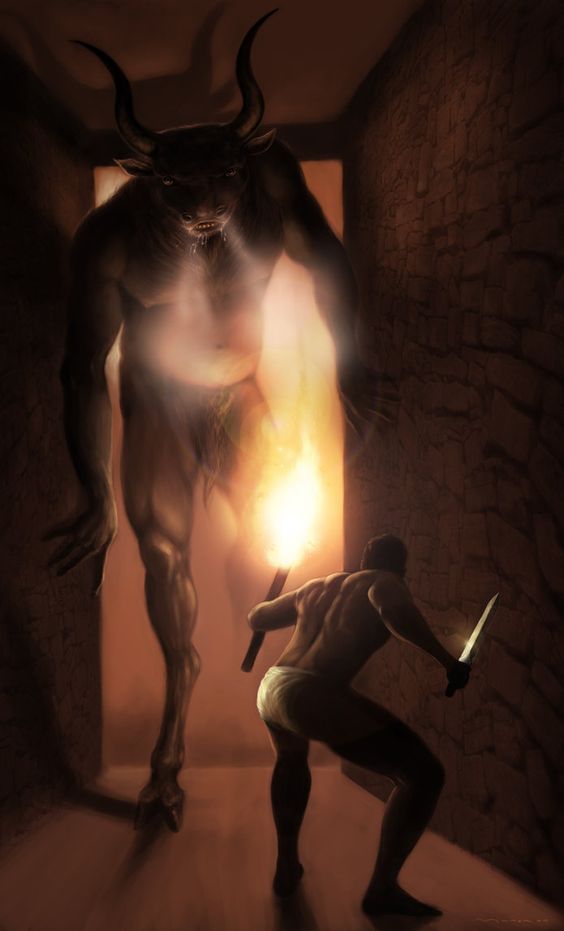Minotaur
This unhappy monster, with the body of man and the head and horns of a bull, was the result of a broken promise and unnatural desire.
His story began when Minos of Crete sought the throne of that kingdom. To impress the Cretans, Minos told them that the gods would answer any prayer he addressed to them, and challenged the Cretans to put him to the test. The Cretans told him to ask Poseidon, Lord of the Ocean, to send him a bull out of the sea, and followed him to the seashore to watch him make this seemingly absurd request. Minos prayed fervently for it to be granted, and promised that if the bull appeared then he would sacrifice it to the glory of Poseidon.
To the awe and astonishment of the Cretan, the waters parted and a magnificent white bull swam ashore. They promptly elected Minos as their king, but he could not bring himself to sacrifice the splendid white bull from the sea. He added it to his own herd, and sacrificed an ordinary bull to Poseidon.
The Ocean God was so infuriated by this broken promise that he caused Pasiphae, the wife of Minos, to fall in love with the bull. She lavished caresses and embraces upon the animal, but it showed no interest in her desire until she persuaded the inventor Daedalus to build her an artifical cow, so that she might crouch within to be served by the bull. In due course she gave birth to a monster with a calf's head and a man's body, which quickly developed into a full-grown male with the head of a great fighting bull. The crescent of its sharp horns was wider than a man could pan with outstretched arms.
The Cretans named it Minotaur, the bullson of Minos, and the king might have accepted this curse of Poseidon if the Minotaur had not developed a taste for human flesh. Minos dared not destroy it lest he offend Poseidon yet again, and so he ordered Daedalus to create a special prison for the monster. Daedalus created the Labyrinth, a maze of chambers and passages built partly above and partly beneath the ground, from which the Minotaur could never find a way out.
At about the time when the Minotaur was born, the king's son Androgeus journeyed to Athens to compete in the Olympic Games. Androgeus was a great athlete, and he won so many of the events that the Athenians barred him from further contests by cutting his throat. Minos responded by attacking the Athenians and laying siege to the city. The siege dragged on until the Athenians begged a truce, but Minos granted it only on condition that, in every ninth year, the Athenians should send seven youths and seven maidens to be devoured by the Minotaur.
In the ninth and eighteenth year after the siege was lifted, the Athenians selected seven handsome youths and seven beautiful maidens and escorted them to the waterfront in a great wailing procession of mourners. The sacrifices boarded a ship with black sails and voyaged to Crete, where the henchmen of King Minos took them one by one to the Lybarinth. Each terrified youngster groped through the gloomy passages until he or she heard the bull-like snuffle of the Minotaur scenting its prey and then met a dreadful fate.
In the twenty-seventh year, Theseus the son of King Aegeus of Athens offered to take the place of one of the victims and try to kill the Minotaur. He promised his father that, if he succeeded, he would change the ship's black sails to white ones on the homeward voyage.

Theseus did not know how he would kill the Minotaur and also find his way out of the Lybarinth, but one part of this problem was solved when Ariadne, daughter of Minos, fell in love with Theseus at first sight. When the guards drove him into the Labyrinth she contrived to slip a ball of thread into his hand. Theseus paid out the thread as he moved boldly into the Labyrinth, listening for the approach of the Minotaur. He walked through the confusing maze of passages until he heard the pad of human feet and then the bull-like bellow as it charged upon the Athenian.
But instead of a juicy youth or maiden the Minotaur encountered an agile warrior who dodged its charge, caught one of its horns and forced it to the ground. Those outside the Lybarinth heard the snarls and roars of fearsome combat as Theseus wrenched the Minotaur's head around by its horns, until he broke its neck whith a ghastly snap.
Theseus found his way back into the open with the help of Ariadne's thread. The young Athenians rejoiced at the victory of their young prince, and the story ended happily for them but not for Ariadne and Aegeus. Theseus proved himself a singularly ungratful lover. He enjoyed Ariadne's favours until the ship reached the island of Naxos on the homeward journey, but when Ariadne fell asleep on the beach he quickly set sail again and left her there.
And, in the triumph of his victory, he forgot his promise to his father. Aegeus had watched every day from the clifftop for the ship's return, and when it hove in sight with the black sails still spread he flung himself down into the sea now known as the Aegean.
